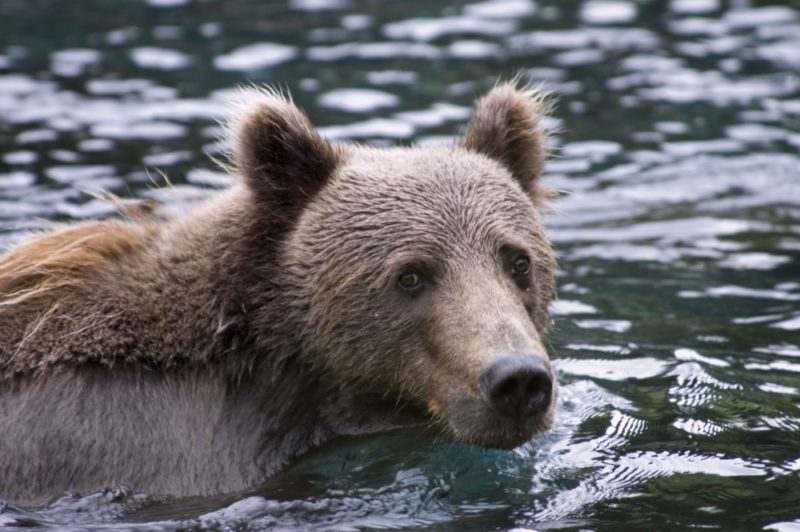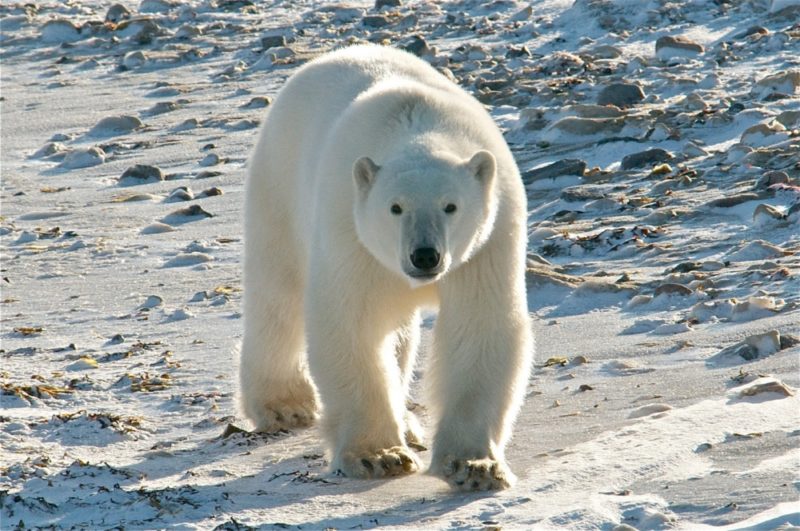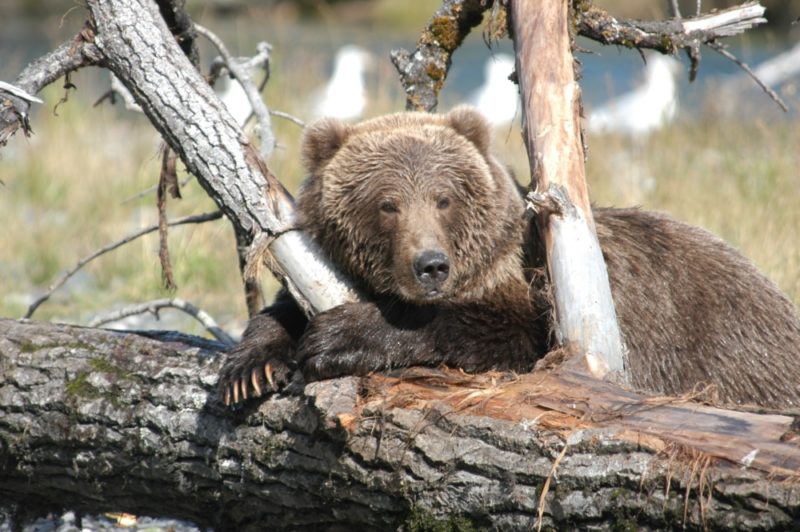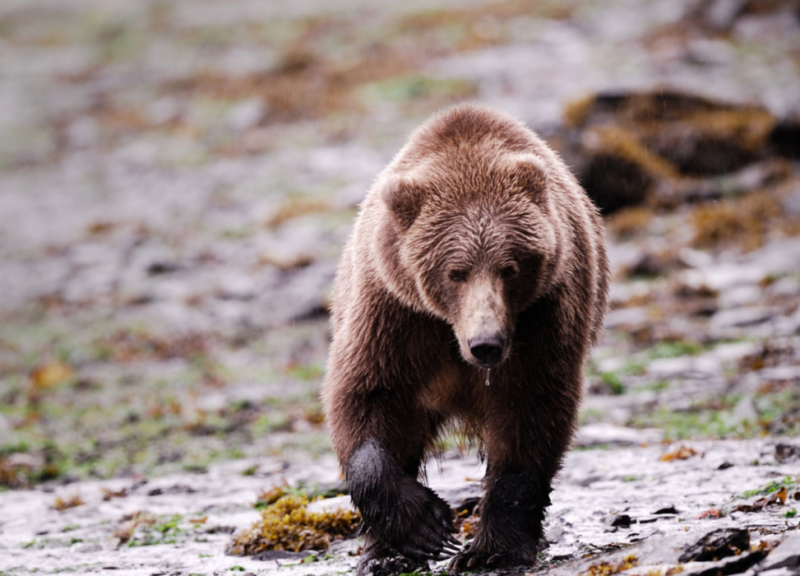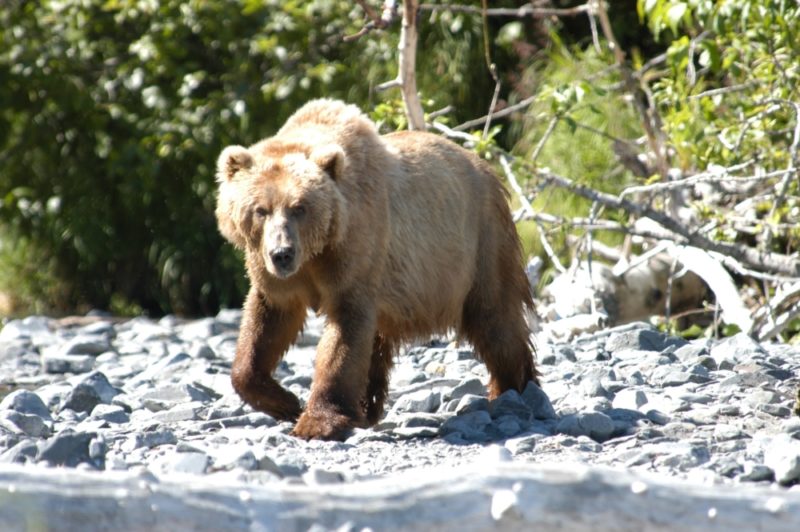In nature, among the predatory land animals, the record holders in size are species from the Bear family. Zoology still has not resolved the issue of which subspecies is the largest bear in the world. But the competitors in the tacit competition remain cognac and polar bear.
Material Content:
Description of appearance and habitat
Both types of bears are characterized by a developed musculoskeletal system and thick durable skin.
The difference is as follows:
- Kodiaks are distinguished by dense brown fur, which protects the beast from frost, which does not prevent the Kodiak bears from lying in their dens for winter hibernation;
- the polar bear is characterized by reduced auricles, an elongated neck and a flattened skull in comparison with a brown bear, as well as a white coat color;
- polar bears go into hibernation only for a month once every couple of years. But females are able to rest for two to three months during pregnancy.
The body of bears is so adapted to the diversity of the diet that they are not predatory in their pure form, belonging to the category of omnivorous animals. But only Kodiaks living in comparatively warmer latitudes are able to use access to diverse food, but their northern brethren are content with meat and seafood.
Polar bear
A polar polar bear originated on the planet more than a hundred thousand years ago, descended from a brown bear. The distribution of the population and adaptation to the environment led to the formation of a northern subspecies adapted to constant frost and survival in snowy areas at temperatures up to -60 degrees.
The largest individuals of the polar bear now live in the Bering Sea, in the coastal areas of the Arctic Ocean, and the total number varies between twenty and thirty thousand.
The average physical characteristics of a polar bear:
- the weight of a polar bear reaches 500 kg for a male, for a female - 300 kg;
- height at the level of the withers - 1, 5 m;
- body length for males - from two to two and a half meters, for females - one and a half to two meters.
The basis of the survival of the polar bear is hunting. The animal hides behind an obstacle and inflicts a deadly paw on the victim. It attacks both walruses and seals, and other inhabitants in the near-water area. It is able to take a place at thawed patches and reservoirs, catching fish.
The skin of a northern bear is distinguished by a paradoxical structure: white wool is used to mask in the snow, and enhanced pigmentation of the skin protects the animal from solar radiation. Indeed, under light hairs the same absolutely black skin hides, which covers the nose of the beast. Under the skin is a fat layer ten centimeters thick, protecting the body from hypothermia in the northern cold.
Kodiak
This species also came from brown bears, named after Kodiak Island off the coast of Alaska, where it was discovered by researchers. But the subspecies also populates other island territories on the Kodiak archipelago, the total population is up to three thousand males and females.
Kodiakov is distinguished by developed muscles with long legs, a wide body and an enlarged skull.
Averaged physical indicators of kodiak:
- the mass of the male is four hundred and fifty kilograms, the female is two hundred and fifty kilograms;
- height at the withers - one and a half meters;
- body length for males is up to 2.8 meters, for females - between one and two meters.
Kodiak brown bear prefers solitary habitat. Active survival is more diverse compared to polar bears - Kodiaks not only hunt and fish from ponds, but also eat berries and plant foods that can eat carrion. The best conditions for Kodiak include a varied diet and the absence of a long winter.
The largest predator in the world - polar bear or kodiak
Data on the record mass of individual specimens does not resolve the scientific debate about which bear is the largest subspecies.
Statements by eyewitnesses and hunters are unreliable and exaggerated, and measuring the performance of all individuals in the population does not seem physically feasible.
For the sake of understanding the essence of the problem, two points should be taken into account:
- The solution will be only to find a consistently regular superiority of animals of a certain subspecies on an average level. Then the representatives of the subspecies may be called the largest.
- At the moment, any definitive answer to the question: “Which bear is the largest in nature?” Comes down to citing specific cases as an example, but not comparing objective information, which contradicts the scientific approach.
Polar bears and Kodiaks, of course, are the largest among relatives, but among themselves the subspecies remain equal in terms of mass and size, which is why the question in zoology remains open. In the future, the problem may be resolved if the population parameters of one of the subspecies increase or decrease due to changing living conditions, forced migration to a new habitat, or genetic mutations.
The Guinness Book of Records for the largest bear is taken to be a polar white subspecies due to the constancy of body weight, while cognac has an increased weight to hibernation and tends to lose it in the spring.
Weight of the largest animal
The record for a polar bear is a body weight of eight hundred kilograms and a body length of three meters. There are references to Kodiak weighing more than a ton and reports of individuals weighing from six hundred to seven hundred and eighty kilograms.But this remains an exception against the background of general mass parameters among both subspecies.
Known weight of the largest individual:
- the largest kodiak in history weighed 680 kilograms;
- the largest polar bear, according to various sources, weighed from nine hundred kilograms to one ton and two kilograms. The body of the animal was three and a half meters in length.
It is worth noting that the parameters of the largest individuals seen in the habitat or killed by hunters remain atypical for the general background of the population.
For example, in 1983, American zoologists caught and examined a bear weighing eight hundred and seventy kilograms, but the study was carried out in conditions of lack of time and tools, therefore the details and membership of the individual are not specified. And also mentioned is the Kodiak bear, which had a body weight of one ton and 134 kilograms. Allegedly, the specimen was caught for the Berlin Zoo, but there are no official sources confirming the precedent.
Hunt for representatives of these species
Both subspecies belong to protected animals; therefore, the extraction of northern bears is prohibited, and the hunting of Kodiaks is subject to strict regulations and restrictions.
The polar bear is listed in the Red Book as a threatened species. The reason is the slow breeding of animals and the maturation of offspring, which is why young individuals become victims of predators. According to official reports, poachers kill at least two hundred polar bears in a year.
The Kodiak subspecies in Alaska is protected as close to extinction, but hunters are allowed to harvest these bears annually in an amount of not more than one hundred and sixty individuals.
Zoologists seek to increase the number of Kodiak subspecies by artificial breeding, the center of which is the officially protected Kodiak National Reserve.
Interesting Facts
In ancient times, the bear was a popular totem animal, which was considered as the patron or even ancestor of people. The reason was the bear’s ability to move, like humans, on its hind legs. And also the anatomical device of the forepaws, similar to the human hand, high intelligence among the representatives of the animal world, as well as the omnivore of the beast.
And also it should be noted:
- Bears are distinguished by developed power and speed indicators. When attacking, they tend not only to strike and bite, but also to clasp the victim with his paws, squeezing her body with effort and literally strangling it in an "embrace";
- documented a precedent when a female polar bear covered seven hundred kilometers, swimming in ice water;
- it has been proven that bears are able to purposefully feed on carrion, leaving fresh prey for two to four days to some degree of decomposition;
- northern bears are able to interbreed with individuals of the grizzly subspecies, equally famous for their impressive size. The cross has received the name "polar grizzly".
Paleontology has established that bears retain the title of largest land predators since ancient times. In the 1930s, at the construction site in Argentina, the ancestor of the Bear family, the prehistoric short-nosed bear, was first found. At the withers, the beast was more than three meters, and its mass is 1600 kilograms. The diet of the predator was made up of wolves and even moose.
Researchers leave open the question of which bear is the largest in nature. But the polar bear remains closer to this category. On the other hand, it is natural to recognize both subspecies as the largest, as individuals of Kodiak and polar bears reach enormous dimensions, and the possibilities of zoologists in examining the animal world remain limited.


